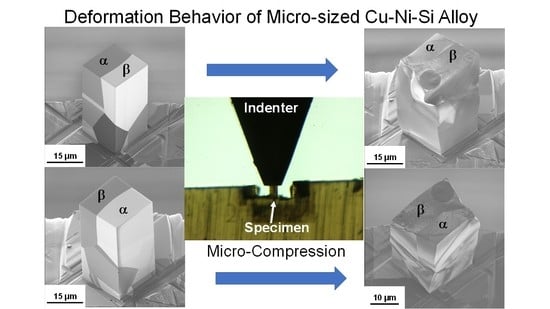Heterogeneous Deformation Behavior of Cu-Ni-Si Alloy by Micro-Size Compression Testing
Abstract
:1. Introduction
2. Materials and Methods
2.1. Sample Composition and Heat Treatment Process
2.2. Fabrication Process
2.3. Micromechanical Testing
3. Results and Discussion
3.1. Mechanical Behavior by Microcompression Test
3.2. Work Hardening Behavior of MicroCompression Test
4. Conclusions
Author Contributions
Funding
Conflicts of Interest
References
- Greer, J.R.; De Hosson, J.T.M. Plasticity in small-sized metallic systems: Intrinsic versus extrinsic size effect. Prog. Mat. Sci. 2011, 56, 654–724. [Google Scholar] [CrossRef]
- Bei, H.; Shim, S.; Miller, M.K.; Pharr, G.M.; George, E.P. Effects of focused ion beam milling on the nanomechanical behavior of a molybdenum-alloy single crystal. Appl. Phys. Lett. 2007, 91, 111915. [Google Scholar] [CrossRef]
- Lilleodden, E. Microcompression study of Mg (0 0 0 1) single crystal. Scr. Mater. 2010, 62, 532–535. [Google Scholar] [CrossRef] [Green Version]
- Jang, D.; Greer, J.R. Size-induced weakening and grain boundary-assisted deformation in 60 nm grained Ni nanopillars. Scr. Mater. 2011, 64, 77–80. [Google Scholar] [CrossRef]
- Nagoshi, T.; Mutoh, M.; Chang, T.F.M.; Sato, T.; Sone, M. Sample size effect of electrodeposited nickel with sub-10 nm grain size. Mater. Lett. 2014, 17, 256–259. [Google Scholar] [CrossRef]
- Zhang, Z.; Shao, C.; Wang, S.; Luo, X.; Zheng, K.; Urbassek, H.M. Interaction of dislocations and interfaces in crystalline heterostructures: A review of atomistic studies. Crystals 2019, 9, 584. [Google Scholar] [CrossRef] [Green Version]
- Huang, K.; Marthinsen, K.; Zhao, Q.; Logéa, R.E. The double-edge effect of second-phase particles on the recrystallization behaviour and associated mechanical properties of metallic materials. Prog. Mater. Sci. 2018, 92, 284–359. [Google Scholar] [CrossRef]
- Uchic, D.; Dimiduk, D.M.; Florando, J.N.; Nix, W.D. Sample dimensions influence strength and crystal plasticity. Science 2004, 305, 986–989. [Google Scholar] [CrossRef] [PubMed]
- Kulkarni, K.M.; Kalpakjian, S. A study of barreling as an example of free deformation in plastic working. J. Eng. Ind. 1969, 91, 743–754. [Google Scholar] [CrossRef]
- Kiener, D.; Grosinger, W.; Dehm, G.; Pippan, R. A further step towards an understanding of size-dependent crystal plasticity: In situ tension experiments of miniaturized single-crystal copper samples. Acta Mater. 2008, 56, 580–592. [Google Scholar] [CrossRef]
- Lee, H.J.; Choi, H.S.; Han, C.S.; Lee, N.K.; Lee, G.A.; Choi, T.H. A precision alignment method of micro tensile testing specimen using mechanical gripper. J. Mater. Process. Technol. 2007, 187, 241–244. [Google Scholar] [CrossRef]
- Lockyer, S.A.; Noble, F.W. Precipitation structure in a Cu-Ni-Si alloy. J. Mater. Sci. 1994, 29, 218–226. [Google Scholar] [CrossRef]
- Araki, A.; Poole, W.J.; Kobayashi, E.; Sato, T. Twinning induced plasticity and work hardening behavior of aged Cu-Ni-Si alloy. Mater. Trans. 2014, 55, 501–505. [Google Scholar] [CrossRef] [Green Version]
- Krupinska, B.; Rdzawski, Z.; Krupinski, M.; Pakieła, W. Precipitation Strengthening of Cu–Ni–Si Alloy. Materials 2020, 13, 1182. [Google Scholar] [CrossRef] [PubMed] [Green Version]
- Yanagida, S.; Araki, A.; Chang, T.F.M.; Chen, C.Y.; Nagoshi, T.; Kobayashi, E.; Hosoda, H.; Sato, T.; Sone, M. Deformation behavior of pure Cu and Cu-Ni-Si alloy evaluated by micro-tensile testing. Mater. Trans. 2016, 57, 1897–1901. [Google Scholar] [CrossRef] [Green Version]
- Nagoshi, T.; Chang, T.F.M.; Sone, M. Evaluations of mechanical properties of electrodeposited nickel film by using micro-testing method. Mater. Trans. 2016, 57, 1979–1984. [Google Scholar] [CrossRef]
- Mutoh, M.; Nagoshi, T.; Chang, T.F.M.; Sato, T.; Sone, M. Micro-compression test using non-tapered micro-pillar of electrodeposited Cu. Microelectron. Eng. 2013, 111, 118–121. [Google Scholar] [CrossRef]
- Zhang, G.P.; Takashima, K.; Higo, Y. Fatigue strength of small-scale type 304 stainless steel thin films. Mater. Sci. Eng. A 2006, 426, 95–100. [Google Scholar] [CrossRef]
- Chan, W.L.; Fu, M.W.; Lu, J.; Liu, J.G. Modeling of grain size effect on micro deformation behavior in micro-forming of pure copper. Mater. Sci. Eng. A 2010, 527, 6638–6648. [Google Scholar] [CrossRef]
- Chen, X.X.; Ngan, A.H.W. Specimen size and grain size effects on tensile strength of Ag microwires. Scr. Mater. 2011, 64, 717–720. [Google Scholar] [CrossRef]






Publisher’s Note: MDPI stays neutral with regard to jurisdictional claims in published maps and institutional affiliations. |
© 2020 by the authors. Licensee MDPI, Basel, Switzerland. This article is an open access article distributed under the terms and conditions of the Creative Commons Attribution (CC BY) license (http://creativecommons.org/licenses/by/4.0/).
Share and Cite
Yanagida, S.; Nagoshi, T.; Araki, A.; Chang, T.-F.M.; Chen, C.-Y.; Kobayashi, E.; Umise, A.; Hosoda, H.; Sato, T.; Sone, M. Heterogeneous Deformation Behavior of Cu-Ni-Si Alloy by Micro-Size Compression Testing. Crystals 2020, 10, 1162. https://doi.org/10.3390/cryst10121162
Yanagida S, Nagoshi T, Araki A, Chang T-FM, Chen C-Y, Kobayashi E, Umise A, Hosoda H, Sato T, Sone M. Heterogeneous Deformation Behavior of Cu-Ni-Si Alloy by Micro-Size Compression Testing. Crystals. 2020; 10(12):1162. https://doi.org/10.3390/cryst10121162
Chicago/Turabian StyleYanagida, Sari, Takashi Nagoshi, Akiyoshi Araki, Tso-Fu Mark Chang, Chun-Yi Chen, Equo Kobayashi, Akira Umise, Hideki Hosoda, Tatsuo Sato, and Masato Sone. 2020. "Heterogeneous Deformation Behavior of Cu-Ni-Si Alloy by Micro-Size Compression Testing" Crystals 10, no. 12: 1162. https://doi.org/10.3390/cryst10121162







